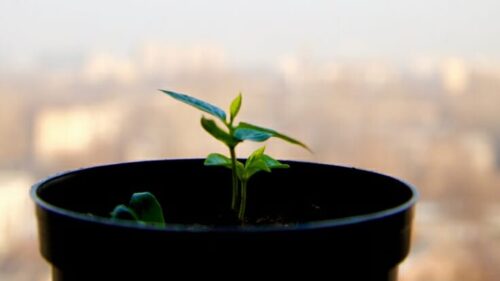Why rocks should not be at the bottom of a potted plant
Many people believe that putting rocks at the bottom of a container with adequate drainage holes is necessary.
But no, it is not.
If you are concerned about the soil coming out of the holes, you can use a piece of landscape fabric at the bottom of the potted plant.
It is highly recommended instead of using rocks. If you don’t have drainage holes in your pot for some reason, then yes, you need a place where water can drain away from the roots.
You can use a layer of rocks, then fabric, then soil, and plant only for containers without holes.
However, it is not helpful for plant growth. If your goal is to increase drainage so the plant roots can get enough oxygen for respiration, this approach does not help potted plants.
What will happen is that the water will somehow be stuck or pooled at the bottom of the pot; coarse gravel will give the water an opportunity to move more freely to the holes of the potted plant.

Why Rocks Should Not Be At The Bottom Of A Potted Plant
Why is it not recommended to To rock in potted plants?
The problem with rocks at the bottom of the potted plants is that water will find and exit the holes of the pot just fine, even without big spaces between gravel chunks at the bottom.
The water in the potted plant that drains instead of staying in the pot is the water that cannot be held against the force of gravity within the medium itself, if you know a little physics.
The medium and the force of gravity are not altered by adding a layer of rocks beneath it.
If you put stones in the bottom of the potted plant, you are just transferring the saturated zone upward by the depth of the stone layer.
Nevertheless, it is always important to realize that the last few inches of media will be highly saturated compared to what is felt in the pot, regardless of whether those last few inches are resting up against the bottom of the pot or against a bed of gravel.
The Best Way To Increase Drainage in a Potted Plant Container
If you want to increase drainage in a potted plant, make a coarser medium. Add some bark, coarse perlite, or something else that creates larger air pockets uniformly throughout the volume of the container.
With regards to drainage, for whatever reason you want to do a lot of gardening using clay or ceramic pots, I would strongly advise you to invest in an electric drill so that you can drill holes in ceramic material pots.
Many of the ceramic pots are sold as planters that have inadequate drainage holes or not enough drainage holes.
Nevertheless, ceramic containers that aren’t necessarily intended for use as planters can be successfully used as planters if you drill some drainage holes in them.
Potted Plant Drainage Holes
The soil in most potted plants consists generally of particles, air, and water.
The space between the soil particles in the pot is called air-pore space.
However, depending on the coarseness of the soil, water will either drain fairly quickly or slowly by following the air pore space to the bottom of the pot, then out the drainage hole.
The soil in pots that has a large percentage of partially composted pine bark pieces, PermaTill, and coarse sand is appropriate for succulents, lavender, and other potted plants that need fast drainage.
Having air in the soil is just as important to roots as water is. Soil like that is considered to have large air-pore spaces.
Most potting soils already have air pore spaces smaller than those described above. Water drains through the soil more slowly, filling the pores until it either drains away, is used by the plant, or evaporates around the holes.
What Happens When You Add Rocks At The Bottom Of The Pot?
What happens when you add rocks to the bottom of the potted plant? The air pore space between those particles gets even larger.
Nevertheless, water does not move readily from soil with small air pore spaces to rock with large air pore spaces.
What will happen is that the water will just sit at the bottom of the soil with a small air pore space and hesitate to move into the rocks.
This is called a perched water table, which means tilting the pot will allow more water to drain.
For a better hands-on experience, you can do the soaked sponge trick to illustrate.
What you can do is soak a rectangular sponge in water until it is fully saturated. Holding it horizontally shows the maximum amount of water that the sponge can hold.
However, if you hold it vertically, with the bottom edge level, it is parallel to the floor. You will see water dripping from the bottom of the sponge, right?
What will happen is that the long axis of the sponge will allow more water to drain as the water quickly passes from one part of the sponge to another.
That means the air pore space is consistent throughout the sponge; water is pulled through, but it eventually stops dripping.
When I set up a potted plant that needs perfect drainage, I usually add a small wad of polyester fiberfill over the holes in the bottom of the pot before adding soil.
Eventually, I would draw some of it through the hole and shape it to a narrow point.
However, as long as the pot is able to shed water, the maximum amount of water will drain from the soil.




